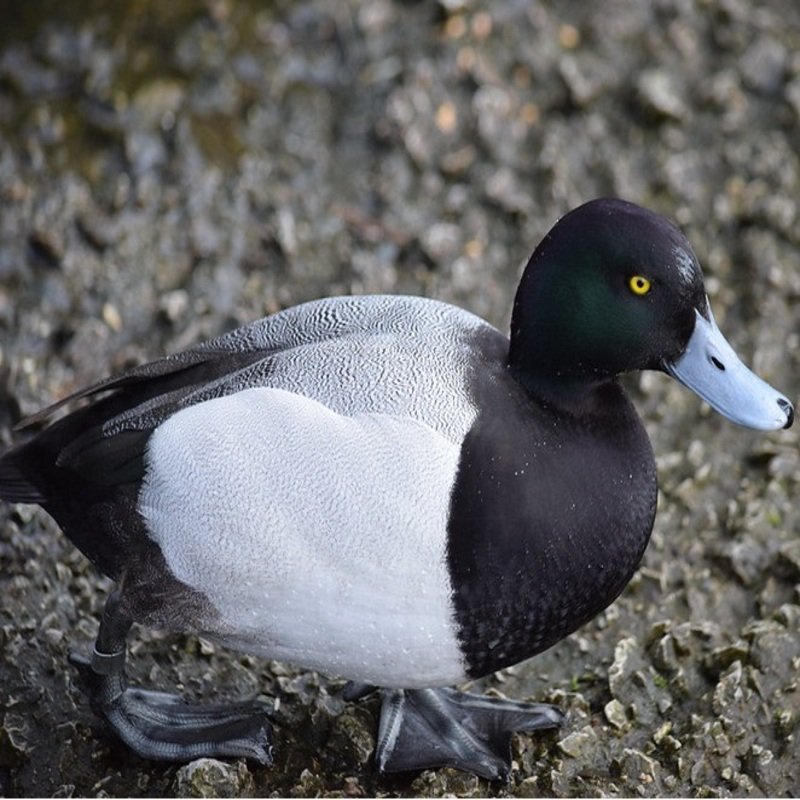The ring-necked duck (Aythya collaris) is a diving duck found in freshwater ponds and lakes throughout North America. The scientific name is derived from the Greek aithuia, a species of unnamed seabird reported by Hesychius and Aristotle, and the Latin collaris, “of the neck,” from collum, “neck.”
Quick Overview: Aythya Collaris – Ring-Necked Duck
Body size: Around 14-18 in (36-46 cm) and a weight of 909 g (32.09 oz).
Main colors: Black, Gray, White
Range: Throughout the United States
Migratory Bird: Yes
Best time of the year to see in the U.S.: January, February, December
Conservation Status: Least Concern
Ring-Necked Duck Description
Adult males are identified by their black head, neck, breast, and upper regions, as well as their pale gray abdomen and flanks. On the folded wing, a conspicuous white wedge stretches upward from the shoulder.

Size
These birds have a length of 14-18 in (36-46 cm) and a weight of 909 g (32.09 oz). Their wings could range from 24-30 in (61-76 cm).
Feeding
Members of this species graze on a variety of plant seeds and tubers found in moist soil, as well as aquatic invertebrates. They occasionally feed on insects. Adults and juveniles feed on aquatic plants such as pondweed, coontail, cow lily, and watermilfoil.
Habitat
Ring-necked Ducks are more generalist feeders than other diving ducks, feeding via shallow dives as well as dabbling at or just beneath the surface. They consume primarily plant debris such as seeds and tubers from submerged vegetation, but also snails, insects, leeches, and other aquatic animals.
Behavior
The species employ a wide variety of wetlands throughout the winter but is rarely seen in places with high salinity levels or depths greater than 1.5 meters. Common habitats include river floodplains, fresh and brackish portions of estuaries, and shallow inland lakes and marshes.
Aythya Collaris Scientific Classification
- Kingdom: Animalia
- Phylum: Chordata
- Class: Aves
- Order: Anseriformes
- Family: Anatidae
- Genus: Aythya
- Species: Aythya collaris
Best time of the year to see
The best time to see these birds in the United States is during the winter season (December to February).
Distribution of the Ring-Necked Duck in the USA
Breeds in Alaska, Manitoba, and Newfoundland, as well as in California, Arizona, the Great Lakes region, and Maine. Winters in southeast Alaska and south along the Pacific coast, then east through the southwest and Gulf Coast states, and finally north to New England.
The Ring-Necked Duck can be found in the following states in the United States – Alabama, Arkansas, Colorado, Connecticut, Delaware, Florida, Georgia, Hawaii, Idaho, Illinois, Indiana, Iowa, Kansas, Kentucky, Louisiana, Maryland, Massachusetts, Michigan, Minnesota, Mississippi, Missouri, Montana, Nebraska, Nevada, New Hampshire, New Jersey, New Mexico, New York, North Carolina, North Dakota, Ohio, Oklahoma, Oregon, Pennsylvania, Rhode Island, South Carolina, South Dakota, Tennessee, Texas, Utah, Vermont, Virginia, Washington, West Virginia, Wisconsin, and Wyoming.

